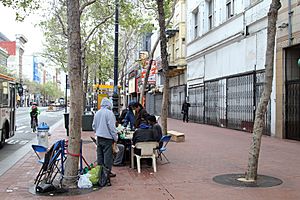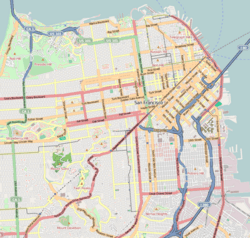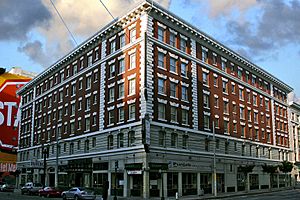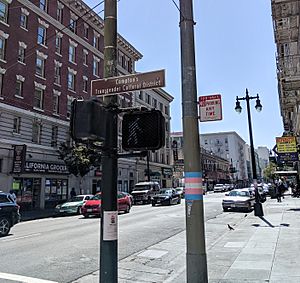Tenderloin, San Francisco facts for kids
Quick facts for kids
Tenderloin
|
|
|---|---|
 |
|
| Nickname(s):
The L's, The Loin, The TL, The Tendy
|
|
| Country | USA |
| State | |
| City-county | San Francisco |
| Named for | Tenderloin, Manhattan |
| Area | |
| • Total | 0.35 sq mi (0.9 km2) |
| • Land | 0.35 sq mi (0.9 km2) |
| • Water | 0 sq mi (0 km2) 0% |
| Population
(2008)
|
|
| • Total | 25,067 |
| • Density | 71,694/sq mi (27,681/km2) |
| Time zone | UTC−8 (Pacific) |
| • Summer (DST) | UTC−7 (PDT) |
| ZIP Codes |
94102, 94103, 94109
|
| Area codes | 415/628 |
The Tenderloin is a neighborhood in downtown San Francisco. It is located on the flatlands near Nob Hill. This area is between the Union Square shopping district and the Civic Center office district.
The Tenderloin covers about 50 city blocks. Its main borders are Geary Street to the north, Mason Street to the east, Market Street to the south, and Van Ness Avenue to the west. The northern part, near Lower Nob Hill, is sometimes called "Tendernob." A section of the western Tenderloin, around Larkin and Hyde Streets, is known as "Little Saigon." This name was given by the City of San Francisco.
Contents
Exploring the Tenderloin's Past
The Tenderloin got its name from an older neighborhood in New York City. That New York area had similar features. One story says a police captain, Alexander S. Williams, could only afford cheap food before working there. But after moving to that neighborhood, he made enough money to buy expensive "tenderloin" meat. Another story suggests officers received extra "hazard pay" for working in a tough area. This extra pay allowed them to afford better food.
The Tenderloin is close to the Mission/Market Street path. This path follows an old Spanish road called El Camino Real. This road itself followed an ancient Native American trail. The neighborhood is protected by Nob Hill. It is also far enough from the bay to be on solid ground. There is proof that people lived here thousands of years ago. In the 1960s, parts of the area were dug up to build the BART/MUNI subway station.
The Tenderloin has been a place where people live since the California Gold Rush in 1849. However, the name "Tenderloin" did not appear on maps until the 1930s. Before that, it was called "Downtown." But people informally used "the Tenderloin" as early as the 1890s. In the late 1800s, the area had a lively nightlife. It had many theaters, restaurants, and hotels.
Almost all buildings were destroyed by the 1906 earthquake. Firefighters also set controlled fires to stop the devastation. But the area was rebuilt very quickly. Some hotels opened by 1907. Apartment buildings, like the historic Cadillac Hotel, followed soon after. By the 1920s, the neighborhood was known for its gambling halls and boxing gyms. It also had secret bars called "speakeasies" during Prohibition. Famous writer Dashiell Hammett lived at 891 Post Street. He wrote detective stories set in the Tenderloin, like The Maltese Falcon.
In the mid-1900s, many musicians worked in the Tenderloin. They played in theaters, hotels, and clubs. The Musician's Union Building was on Jones Street. The most famous jazz club was the Black Hawk. Famous musicians like Miles Davis and Thelonious Monk recorded live albums there.
After World War II, the Tenderloin's population decreased. Many homes became empty by the 1970s. But starting in the late 1970s, many refugees from Southeast Asia moved in. These included people from Vietnam, Cambodia, and Laos. The low-cost housing and closeness to Chinatown made the area attractive. Studio apartments became homes for families. The number of children in the Tenderloin grew from a few to over 3,500. Many Southeast Asian restaurants and grocery stores opened then, and they are still there today.
In 1966, an important event happened at Compton's Cafeteria. Police tried to arrest a drag queen, which led to a protest. This event helped form the Gay Activists Alliance. Before The Castro became a major gay neighborhood, the Tenderloin was one of the city's first gay areas. Some historic gay bars and clubs still exist there.
In July 2008, the Tenderloin was named a historic district. This means its buildings and history are protected. In 2017, a part of the area became the Compton's Transgender Cultural District. This district honors the transgender community and the 1966 protest at Compton's Cafeteria.
What Makes the Tenderloin Special?
The Tenderloin is located near the downtown area. It has kept its unique character over time. Part of the neighborhood is also home to the city's theater district.
Arts and Entertainment
Many famous theaters are in the Tenderloin. These include the Geary, home of the American Conservatory Theater. Other big theaters are the Curran, Golden Gate, and Orpheum Theatres. There are also smaller, alternative theaters like EXIT Theatre and the New Conservatory Theater. Art galleries like The Luggage Store also add to the creative scene.
The neighborhood has many bars, some dating back to the time of Prohibition. One bar, Bourbon and Branch, is built on the site of an old secret speakeasy. Many bars offer entertainment, including the historic drag bar Aunt Charlie's. Larger music venues include the Great American Music Hall and the Warfield Theatre.
The Tenderloin is also an important place for the gender diverse community. Many activists from this community have worked for change here.
Community Art and Murals
The Tenderloin is a center for art in San Francisco. It has galleries like "White Walls" and "Shooting Gallery." The neighborhood is also famous for its murals. Artists like Banksy and Shepard Fairey have created art here.
Helping the Community: Social Services
The Tenderloin is a diverse community. It includes families, young people, artists, and new immigrants. Many non-profit groups and social service agencies are in the area. They help people who are experiencing homelessness or living in poverty.
Raphael House has been providing shelter for homeless parents and children since 1971. The Tenderloin Housing Clinic also offers important services to the community. The Care Through Touch Institute gives free massage therapy to people in the Tenderloin.
Many religious groups also help the community. Glide Memorial Church and St. Anthony's provide meals and other services. San Francisco City Impact founded the San Francisco City Academy, a K-8 school, in 1997. This was the first K-8 school in the Tenderloin.
In 2008, The Salvation Army opened the Ray and Joan Kroc Community Center. This center has a gym, swimming pool, and fitness center. It was funded by a large gift from Joan Kroc. Next to it is Railton Place, an apartment complex for young people who used to be in foster care, veterans, and people recovering from addictions.
The Tenderloin Community Benefit District works to keep the streets clean and beautiful. There is also a project called 'TRANS' that helps transgender women get health care and support.
The Tenderloin Senior Organizing Project helps older adults. They create opportunities for seniors to meet and talk. Larkin Street Youth Services is a group that helps young people move beyond living on the streets. They offer shelters, health services, and education programs.
Culture and Creativity in the Tenderloin
In 1987, residents started the 509 Cultural Center. After an earthquake damaged it, artists created the Luggage Store Gallery. The Tenderloin Reflection and Education Center (TREC) also offers workshops in dance, music, and writing. Their literary journal, Tender Leaves, was published for many years.
From 2006 to 2009, The Loin's Mouth was a publication about life in the Tenderloin. Now, there is the Tenderloin Reading Series and The Tender, a local journal.
Gray Area Foundation for the Arts was formed in 2006. It focuses on new media technologies and creativity. The local Vietnamese Community has also hosted the Tết celebration, which is the Vietnamese Lunar New Year, in the Little Saigon area.
Parks and Green Spaces
For a long time, the Tenderloin did not have many parks. But in the 1970s, activists worked to create more open spaces. As a result, several parks and playgrounds were built.
Boeddeker Park
Boeddeker Park is at Eddy and Jones Streets. It is one of the most used parks in the city. It was renovated in 2014 and is now a lively place. The YMCA and Boys and Girls Club offer programs for young people and seniors there. Police Captain Jason Cherniss called it "the hub of positive community togetherness."
Tenderloin Children's Playground
The Tenderloin Children's Playground opened in 1995. It is on Ellis Street. It has fun indoor and outdoor play areas. It also hosts many community and family events.
Sgt. John Macaulay Park
Sgt. John Macaulay Park is a small, fenced playground. It is named after a police officer who was killed nearby. It is located at O'Farrell and Larkin Streets.
Tenderloin National Forest
The "Tenderloin National Forest" is an unofficial park. It was started in 1987 by The Luggage Store/509 Cultural Center. It is located on Cohen Alley, just off Ellis Street.
Why the Name "Tenderloin" Stays
In 2011, a group called People for the Ethical Treatment of Animals (PETA) suggested changing the neighborhood's name. They wanted to call it the "Tempeh District" after a plant-based food. They said the city deserved a name not related to animal meat. However, locals did not like the idea. Mayor Ed Lee said it was more important to improve the lives of residents than to change the name. So, the name "Tenderloin" remains.
See also
 In Spanish: The Tenderloin para niños
In Spanish: The Tenderloin para niños




